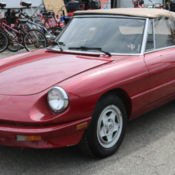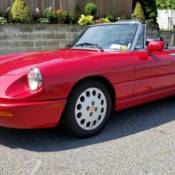1994 Alfa Romeo Spider Veloce Convertible 2-Door 2.0L
1994 Alfa Romeo Spider for sale in Etobicoke, Ontario, Canada
| Item location: |
Etobicoke, Ontario, Canada |
| Make: |
Alfa Romeo |
| Model: |
Spider |
| Type: |
Convertible |
| Trim: |
Veloce Convertible 2-Door |
| Year: |
1994 |
| Mileage: |
64,931 |
| VIN: |
zarbb32nxr7008453 |
| Color: |
Red |
| Fuel: |
Gasoline |
| Transmission: |
Manual |
| Drive type: |
RWD |
| Interior color: |
Tan |
| Vehicle Title: |
Clear |
| Want to buy? |
Contact seller!
|
Description for Alfa Romeo Spider 1994
This is a Beautiful Classic... the last year Alfa Romeo produced the Spider Veloce Convertible. It will only continue to appreciate in value.It has only traveled under 65000 miles since new. Garage kept and well maintained. This car has been pampered and it shows.Call me anytime fort further information 416-802-9999 David StevensA lot happens in thirty years. Vibrant tie-dyed youth in paisley patterned Volkswagens turn into graying commuters stuck in sterile white Camrys. Fuel crises come and go. Time slowly reduces the automobile once a potent symbol of sex and freedom to a bland and inoffensive mass of soft plastic crumple zones and gray velour: an air bag-lined capsule of toiling isolation. Engine sizes shrink and subsequently grow again. Hairlines recede (but unfortunately don't grow back with the cubic inch revival). The presidencies of Lyndon Baines Johnson and Bill Clinton sandwich the administrations of a liar a peanut farmer a handsome actor and more. The Soviet Union collapses. Enzo Ferrari dies.In less than three decades between 1966 and 1994 the world changed in unforgettable ways. The automotive landscape reflected these changes; it bore the scars of crippled performance and compromised style and the fruits of enhanced efficiency and increased safety. Cars changed radically in those years. Most notably the idea of automotive fun was all but eradicated. The EPA and Ralph Nader created a fun-sucking black hole that manufacturers struggled to claw out of for years with almost no success until the Mazda Miata of 1989 revitalized a dying species and added a sultry tint of red to the cold gray monochrome into which it was born.But when the Miata that great savior of the sports car arrived to carry on the torch first lit by traditional ash-framed Brits after the Second World War it had to pry that beacon of light from the ageing fingers of a car that refused to die: the Alfa Romeo Spider.Alfa's Spider was a survivor. Introduced in 1966 to a world rife with sports car choices the Spider was always a bit of a misfit. With less performance than a Porsche more sophistication than an MG and a price tag in-between the costs of those marques' machines the Alfa seemed to occupy a logical position within the sports car hierarchy.Real sports cars didn't follow rules though and they didn't always play nice. The Spider would not allow itself to be pigeonholed into some anonymous niche between carmakers with whom Alfa had battled for years on racetracks and on dealer lots. The Alfa Spider set itself apart from competitors with engineering precision unmatched by other cars of similar size and price. It was stylish too but the lines were ahead of their time. When it was new the Spider managed to receive the nickname Osso di Seppia in its home country of Italy. English translation: cuttlefish. The Spider's initial design was the last work overseen by Pininfarina founder Batista 'Pinin' Farina and it was a well proportioned shape with a tapering tail to balance its long sloping nose with covered headlights. How this shape struck period journalists as fishy is difficult to understand as automotive historians and journalists now regard it as pure and delicate the finest of the Spider series. John Lamm writing for Motor Trend decades ago remarked that the 'Spider looked like it had been squeezed from a tube of Crest.' The design has reached high regard though and the premium prices enjoyed by early Spiders confirm the shape's ultimate success.Maybe contemporary journalists were just trying to nitpick—there were after all no other detractors from the car's inherent goodness about which one could complain. This may sound like an exaggeration. It isn't. The original Alfa Romeo Spider did everything well and reviews from the car's inception confirm this.Handling was brilliant. The race-proven suspension setup used coil springs and telescoping shock absorbers at all corners with unequal length A-arms at the front and a carefully located rear axle. The Spider had neither rack and pinion steering nor independent rear suspension but it proved that excellent handling could be had without them. The four wheel disc brakes gave the Spider sensationally short stopping distances. The car's interior was comfortable its top easy to operate its build quality decent and its reliability proven (at least when treated to appropriate maintenance work by a knowledgeable mechanic). And things only got better when someone opened the hood.Featuring the venerated Alfa twin cam four the Spider's engine bay sparkled with Italian charisma. Beautifully cast aluminum marked the distinguished motor as a work of art a decadent sculpture given for the gods motion. From top to bottom the engine was a triumph of form and purpose. An aluminum valve cover crowned the head with a shape indicative of the twin chain-driven camshafts beneath it. Those camshafts actuated valves within hemispherical combustion chambers with a spark plug optimally situated between the valves at each hemisphere's northernmost point. Digging deeper into the engine the aluminum block came into view. It used cast iron wet liners to ensure durability and longevity even with enthusiastic use. Finally at the very bottom of the engine bay excavation was the oil sump also in aluminum. The oversized sump was responsible for the engine's 7-quart oil capacity. Its distinctive hammerhead shape resulted from a need to clear a cross member running directly beneath the motor and its fins and baffles kept the oil happy while the car encountered high engine speeds and cornering loads.That engine mated to a 5-speed transmission that automotive writers widely accepted as one of the very finest gearboxes in terms of feel and ease of use. The excellent transmission routed power to the rear axle where Alfa used more aluminum in the differential casing.Few reasonably-priced sports cars bettered the Alfa Spider yet the car was never a particularly popular seller. Even its co-starring role in The Graduate with Dustin Hoffman didn't deliver sustained high sales. Alfa Romeo suffered from weak marketing skills and an awful dealer network (especially in the United States) which coupled with a price higher than that of some British competitors kept the Spider a relatively exclusive car. The 1966 Alfa Romeo Spider was an excellent machine but it never got any better—and it certainly never grew any younger. Despite the exceptionally long production run that the Spider enjoyed Alfa never made any thorough revisions to the basic design. That was fine for purist Alfisti but for everyone else the competition just looked better and better. Of course that was not a problem for those few years in the 1980s when competition just didn't exist. But even then the Spider was so familiar and admittedly tired that it failed to rouse buyers in great numbers.Regardless though the Spider did clearly age it aged gracefully and remained a faithful friend to the sports car hopeful. Throughout its long life the Spider was produced in many variations for many different markets. The series arrived in 1966 with a model called the Duetto.The Alfa Duetto was one of the curved-tail Spiders and it used a 1570cc version of the Alfa twin cam. Succeeding the Duetto in the U.S. market was the Spider Veloce of 1969 (no Alfas were imported to the U.S. for 1968) which used a 1779cc engine and the advanced SPICA mechanical fuel injection system. In 1971 (no U.S.-bound Alfas in 1970) the Spider Veloce continued with the 1779cc engine but the curved-tail styling disappeared replaced by a more conventional Kamm-tail treatment.All American market Alfa Spiders from 1972 used a 1962cc version of the all-alloy engine. For 1975 the U.S. cars received ungainly bumpers to meet new federal standards. This compromised design continued until 1982 with more thorough revisions updating the Spider's appearance for 1983.The 1983 models gained better-integrated (though still bloated) bumpers a metal front spoiler and a revised rear end with new taillight clusters and a soft rubber spoiler. By this time Spiders used Bosch electronic fuel injection that improved reliability though not performance. In 1985 a new trim level called the Graduate was introduced to capitalize on Alfa's brief moment of stardom nearly twenty years prior. The Spider Graduate slotted below the Spider Veloce and was the entry-level model with vinyl seats and top manual windows and steel wheels.In 1986 the Spider series received a revised interior and yet another trim level: the Quadrifoglio. The top-of-the-line Spider Quadrifoglio possessed an interior similar to that found in the Veloce but with blood red carpets and gray leather seats with contrasting red stitching. On the outside the Quadrifoglio was distinctively styled with a controversial plastic body kit that consisted of front and rear lower bumpers as well as side skirts. It also came with unique 15' alloy wheels and a removable hardtop. Alfa offered the Quadrifoglio in only three colors: red silver and black. Graduate Veloce and Quadrifoglio trims were offered to American buyers until 1990. For 1991 the Alfa Spider received its final freshening. The interior was updated but the most important changes were made to the body. Alfa Romeo fitted these Spiders with well-integrated front and rear bumpers revised outer rocker panels and a new tail that eschewed the 1980s-style spoiler and light clusters for a smoother look with full-width taillights inspired by the Alfa 164. Pininfarina which built Alfa Romeo's Spiders in addition to designing them produced its last examples of the model in calendar year 1993. For the 1994 model year 190 Alfa Romeo Spider Commemorative Editions were imported into the U.S. to mark the very end of the series. The Alfa Spider became less and less competitive as it aged slowly turning into the kind of tweedy anachronism usually produced by Britain. It never lost its charm though. The snarling twin cam the crisp 5-speed the cozy interior with its comically awful driving position—the Alfa Spider was everything a car should be except practical safe and sensible. In other words it was everything a sports car should be. Never pretentious never ostentatious and somehow always in style. If people could only age as well as the Spider maybe growing old wouldn't be so bad. Then again from behind the wheel of a Spider it doesn't even matter that we age. This car is timeless. Endless. Eternal. There's an air of immortality and invincibility about the Alfa. No matter how old it is no matter how old we are—just double-clutch downshift a couple gears to make that twin cam scream and the story starts all over again.
Other classic cars for sale
 1986 Alfa Romeo Spider Veloce Convertible - 5-Speed - Alfa Red - 2-Door Coupe
1986 Alfa Romeo Spider Veloce Convertible - 5-Speed - Alfa Red - 2-Door Coupe
 1994 ALFA ROMEO SPIDER VELOCE CONVERTIBLE, COMMEMORATIVE EDITION, ONLY 37K MILES
1994 ALFA ROMEO SPIDER VELOCE CONVERTIBLE, COMMEMORATIVE EDITION, ONLY 37K MILES
 Alfa Romeo Spider Veloce Convertible 2-door
Alfa Romeo Spider Veloce Convertible 2-door
 1976 Alfa Romeo Spider Veloce Convertible 2-Door 2.0L
1976 Alfa Romeo Spider Veloce Convertible 2-Door 2.0L